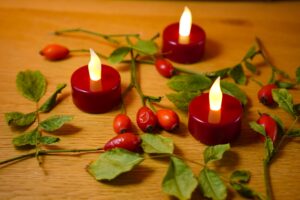The process is a fairly straightforward one, though many seem pretty mystified by it. In many respects Lavender Oil distillation hasn’t changed for centuries. It’s also not too different from the distillation of alcohol: relying on the same principles!
At the peak of our lavender harvest we usually do 4 distillations each day in our two stills. Our biggest still takes about 80kg fresh weight of lavender, and it takes about an hour distil the oil out. The lavender is packed into a steel mesh basket, weighed (at the end of the process we marry up the weight of oil with the weight of plant material to get an oil yield). The basket is winched into the stainless steel still. A lid is put on and bolted down. Steam is then introduced under pressure into the bottom of the still from our oil-fired boiler. The steam at 100°C rapidly rises through the lavender, heating it up.
All the different chemical components that make up the lavender oil (which is stored in tiny vesicles along the sides of each flower bud) have a boiling point less than the temperature of the steam. When heated by the steam the lavender oil boils, it expands, bursts out of the oil vesicles and in vapour form rises with the steam to the top of the still.
The steam and oil vapour pass through a short pipe into a water-cooled condenser. Here it is all cooled back to water and minute lavender oil droplets. This flows into a special glass flask – called a florentine flask – where the liquid settles and separates out into a water layer and a lavender oil layer. The lavender oil is lighter than water and being an oil does not mix with water so it floats on the top as a beautiful, golden coloured layer. From the flask the oil is drawn off and stored away carefully.
The excess water is returned to the bottom of the still, where eventually, after the distillation process it goes to waste. It smells like stewed grass, and is the colour of tea! We do sometimes keep the first 10 litres of water that is distilled off. This hydrosol, as it’s called, contains a very low level of lavender oil and can be used as ironing water, in cosmetics etc.
We also end up with a basket full of wet, soggy, discoloured, distilled lavender flowers. It is also sterile since it has has hot stem put through it. However we empty it all out onto a large heap, layer it up with other garden waste to put the bugs and bacteria back in, and turn it into compost for recycling on the farm.
Steam Distillation Of Lavender Essential Oil
It may not come as a surprise to you that here on our lovely Jersey Lavender Farm, we absolutely love our lavender – so much so that we have some lavender plants that are over 20 years old! And as a result, we are dedicated to making sure that we treat our lavender with the utmost care at every stage of its lifecycle. Whether it’s nurturing new lavender plants in the nursery, tending to our established plants and bringing them to bloom, harvesting the lavender with the utmost care and at exactly the right moment to ensure the gorgeous oil is at its very best, drying it with patience and care, expertly distilling the essential oil or hand crafting our range of fantastic products.
Each of these steps requires skill and dedication, but today we thought that we’d let you into a few secrets of the distilling process, that is exactly how we extract the essential oils from our lovely lavender.
Here at Jersey Lavender, we believe that the very best method of extracting the essential oil from lavender is to use steam distillation. The still itself consists of 4 main parts; a heat source, the distilling chamber, a condenser, and a collection vessel. To extract essential oils from lavender, there are a number of steps:
1. Place the lavender buds and flowers inside the distilling chamber.
2. Seal the still and ignite the heat source underneath the water, which is at the bottom of the chamber.
3. Increase the pressure inside the chamber. This will ensure that delicate volatile constituents of the oil boil and evaporate at a lower temperature, thus ensuring that they are not damaged or compromised during the distillation process.
4. As the water boils, steam is released which breaks through the plant material and releases the essential oils, which then evaporate in the steam.
5. The mixture of essential oils and steam then rise up to the top of the distillation chamber, where they then enter the condenser.
6. The condenser is a cooled tube which runs downwards from the top of the condenser. When the vapour hits the surface of the tube, it cools and turns back into liquid, which is a mixture of water and the essential oil.
7. This liquid then drips down into the collecting vessel, where the essential oil and water separate and the oil can be collected.
Of course, this makes the process sound somewhat simpler than it actually is, as setting and maintaining the precise pressure and temperature to ensure that the essential oil is fully extracted without being anyway damaged often feels more like an art form than a science. However, when we get to sample a new batch of perfect Jersey Lavender Essential Oil, it all feels worthwhile!
Read related articles:






2 Comments
Interesting to see it done in large quantities. Was hoping to find a piece written about alambics.
Hi Joseph,
‘Fraid I have no experience of what a distillation service is worth. What I’d do is track down the facebook group – The Business of Lavender – try to join and post a comment. It’s an invitation only group but I’m sure you can contact the mediator thru the page. I’m sure that there are lavender growers who have only just started out and would prefer to have their oil distilled by someone else rather than invest in the equipment, until they know more. Good luck.
Comments are closed.